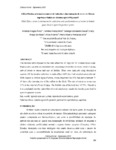Por favor, use este identificador para citar o enlazar este ítem:
http://www.alice.cnptia.embrapa.br/alice/handle/doc/952195Registro completo de metadatos
| Campo DC | Valor | Lengua/Idioma |
|---|---|---|
| dc.contributor.author | ÁVIDA, A. A. | pt_BR |
| dc.contributor.author | BRITO, I. F. | pt_BR |
| dc.contributor.author | SOUSA, S. D. | pt_BR |
| dc.contributor.author | ABREU, D. A. de | pt_BR |
| dc.contributor.author | ANDRIOLI, A. | pt_BR |
| dc.contributor.author | SILVA, P. A. F. da | pt_BR |
| dc.date.accessioned | 2013-03-05T11:11:11Z | pt_BR |
| dc.date.available | 2013-03-05T11:11:11Z | pt_BR |
| dc.date.created | 2013-03-05 | pt_BR |
| dc.date.issued | 2012 | pt_BR |
| dc.identifier.citation | Ciência Animal, Fortaleza, v. 22, n. 1, p. 342-344, 2012. suplemento. | pt_BR |
| dc.identifier.uri | http://www.alice.cnptia.embrapa.br/alice/handle/doc/952195 | pt_BR |
| dc.description | Male Effect, natural alternative for induction and synchronization of estrus in female goats bred in agrosilvopasture system. Abstract: The females were exposed to the male effect for 45 days for 80 minutes twice a day. Reproductive parameters recorded were: percentage of females in estrus, onset of estrus, rate of return to estrus and rate of fertility. Data were analyzed using descriptive statistic. Of the females submitted to male effect 100% they had revealed estrus clinical. With respect to clinical signs of estrus, it was observed that 69% had estrus between 7-10 days after introduction of the ruffian in the flock. The rate of return to estrus was 25% in the interval of 8 to 24 days. The fertility rate of the herd was 93.75%. Therefore it is concluded that the male effect showed satisfactory results for female goats bred in agrosilvopasture system. | pt_BR |
| dc.language.iso | por | pt_BR |
| dc.rights | openAccess | pt_BR |
| dc.title | Efeito macho, alternativa natural de indução e sincronização de estro em fêmeas caprinas criadas em sistema agrossilvipastoril. | pt_BR |
| dc.type | Artigo em anais e proceedings | pt_BR |
| dc.date.updated | 2019-04-04T11:11:11Z | pt_BR |
| dc.subject.thesagro | Caprino | pt_BR |
| dc.description.notes | Trabalho apresentado no 6o. Congresso Norte Nordeste de Reprodução animal, 2012, Fortaleza. | pt_BR |
| riaa.ainfo.id | 952195 | pt_BR |
| riaa.ainfo.lastupdate | 2019-04-04 -03:00:00 | pt_BR |
| dc.contributor.institution | Amanda Aragão Ávila, Pós-graduação - Universidade Estadual Vale do Acaraú (UVA) - Sobral, CE | pt_BR |
| dc.contributor.institution | Ismênia França Brito, Pós-graduação - Universidade Federal do Ceará (UFC) - Sobral, CE | pt_BR |
| dc.contributor.institution | Solange Damasceno Sousa, Pós-graduação - UVA - Sobral, CE | pt_BR |
| dc.contributor.institution | Darly Araújo de Abreu, Pós-graduação - UVA - Sobral, CE | pt_BR |
| dc.contributor.institution | ALICE ANDRIOLI, CNPC | pt_BR |
| dc.contributor.institution | Pedro Alberto Freitas da Silva, Instituto Superior de Teologia Aplicada - Sobral, CE. | pt_BR |
| Aparece en las colecciones: | Artigo em anais de congresso (CNPC)  | |
Ficheros en este ítem:
| Fichero | Descripción | Tamaño | Formato | |
|---|---|---|---|---|
| aacEfeitomacho.pdf | 269.97 kB | Adobe PDF |  Visualizar/Abrir |









